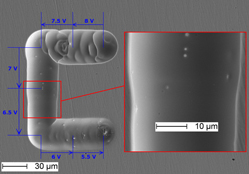Crossref Citations
This article has been cited by the following publications. This list is generated based on data provided by
Crossref.
Sueptitz, R.
Dunne, P.
Tschulik, K.
Uhlemann, M.
Eckert, J.
and
Gebert, A.
2013.
Electrochemical micromachining of passive electrodes.
Electrochimica Acta,
Vol. 109,
Issue. ,
p.
562.
Gebert, A.
Gostin, P. F.
Sueptitz, R.
Oswald, S.
Abdi, S.
Uhlemann, M.
and
Eckert, J.
2014.
Polarization Studies of Zr-Based Bulk Metallic Glasses for Electrochemical Machining.
Journal of The Electrochemical Society,
Vol. 161,
Issue. 4,
p.
E66.
Horn, Sylvia
Oswald, Steffen
Stoica, Mihai
Uhlemann, Margitta
and
Gebert, Annett
2015.
Complex microshaping of bulk metallic glass surfaces by electrochemical means.
Journal of Materials Research,
Vol. 30,
Issue. 22,
p.
3493.
Sueptitz, R.
Horn, S.
Stoica, M.
Uhlemann, M.
and
Gebert, A.
2015.
Electrochemical micromachining of passive electrodes – Application to bulk metallic glasses.
Journal of Materials Processing Technology,
Vol. 219,
Issue. ,
p.
193.
Zeng, Yongbin
Meng, Lingchao
and
Fang, Xiaolong
2017.
Surface Characteristics of Ni-Based Metallic Glass in Wire Electrochemical Micro Machining.
Journal of The Electrochemical Society,
Vol. 164,
Issue. 13,
p.
E408.
Meng, Lingchao
Zeng, Yongbin
and
Zhu, Di
2017.
Investigation on Wire Electrochemical Micro Machining of Ni-based Metallic Glass.
Electrochimica Acta,
Vol. 233,
Issue. ,
p.
274.
Meng, Lingchao
Zeng, Yongbin
Fang, Xiaolong
and
Zhu, Di
2017.
Micropatterning of Ni-based metallic glass by pulsed wire electrochemical micro machining.
Intermetallics,
Vol. 81,
Issue. ,
p.
16.
Debnath, S.
Doloi, B.
and
Bhattacharyya, B.
2019.
Review—Wire Electrochemical Machining Process: Overview and Recent Advances.
Journal of The Electrochemical Society,
Vol. 166,
Issue. 10,
p.
E293.
Meng, Lingchao
Zeng, Yongbin
and
Zhu, Di
2019.
Wire electrochemical micromachining of Ni-based metallic glass using bipolar nanosecond pulses.
International Journal of Machine Tools and Manufacture,
Vol. 146,
Issue. ,
p.
103439.
Wu, Xiujuan
Sang, Yumeng
Yang, Tao
and
Zeng, Yongbin
2020.
Fabrication of Fe-based metal glass microelectrodes by a vertical liquid membrane electrochemical etching method.
Review of Scientific Instruments,
Vol. 91,
Issue. 3,
Hang, Yusen
Zeng, Yongbin
Yang, Tao
and
Meng, Lingchao
2020.
The dissolution characteristics and wire electrochemical micromachining of metallic glass Ni82Cr7Si5Fe3B3.
Journal of Manufacturing Processes,
Vol. 58,
Issue. ,
p.
884.
Graeve, Olivia A.
García-Vázquez, Mireya S.
Ramírez-Acosta, Alejandro A.
and
Cadieux, Zachary
2023.
Latest Advances in Manufacturing and Machine Learning of Bulk Metallic Glasses.
Advanced Engineering Materials,
Vol. 25,
Issue. 9,
Arshad, Muhammad Hazak
Saxena, Krishna Kumar
Huang, Shuigen
and
Reynaerts, Dominiek
2024.
Macro and micro-scale material removal mechanisms during ECM/hybrid laser-ECM of a passivating multiphase NbC–Ni cermet.
International Journal of Machine Tools and Manufacture,
Vol. 200,
Issue. ,
p.
104182.



